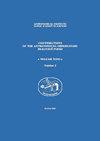Stochastic nonlinear self-oscillatory model of an accretion disk for the X-ray bursting of the microquasar GRS 1915+105
IF 0.2
4区 物理与天体物理
Q4 ASTRONOMY & ASTROPHYSICS
Contributions of the Astronomical Observatory Skalnate Pleso
Pub Date : 2023-02-01
DOI:10.31577/caosp.2023.53.1.7
引用次数: 0
Abstract
. The observed light curves of the microquasar GRS 1915+105 show three main characteristics, namely chaotic, stochastic and semi-stochastic (or nonstochastic). In order to probe the origin causing these different features, we propose a stochastic nonlinear self-oscillatory model of an accretion disk, and use its oscillating luminosities with different noise strengths and nonlinear factors to simulate the observational variability, and compare their correlation dimensions calculated by a nonlinear time series analysis. It is shown that when the stochastic noise strength is small and the nonlinear factor is large, the luminosity curves show chaotic behavior. On the contrary, it shows stochastic or semi-stochastic behavior when a stochastic factor dominates. The simulated data exhibits the same nonlinear and random characteristics as the observational sequences, and their corresponding correlation dimensions are also consistent. This indicates that the X-ray bursting of the microquasar should be related to a nonlinear self-oscillation of the accretion disk.微类星体GRS 1915+105 x射线爆发吸积盘的随机非线性自振荡模型
本文章由计算机程序翻译,如有差异,请以英文原文为准。
求助全文
约1分钟内获得全文
求助全文
来源期刊
CiteScore
1.10
自引率
20.00%
发文量
4
审稿时长
>12 weeks
期刊介绍:
Contributions of the Astronomical Observatory Skalnate Pleso" (CAOSP) is published by the Astronomical Institute of the Slovak Academy of Sciences (SAS). The journal publishes new results of astronomical and astrophysical research, preferentially covering the fields of Interplanetary Matter, Stellar Astrophysics and Solar Physics. We publish regular papers, expert comments and review contributions.

 求助内容:
求助内容: 应助结果提醒方式:
应助结果提醒方式:


